The Firs, Rollesby Road, Martham
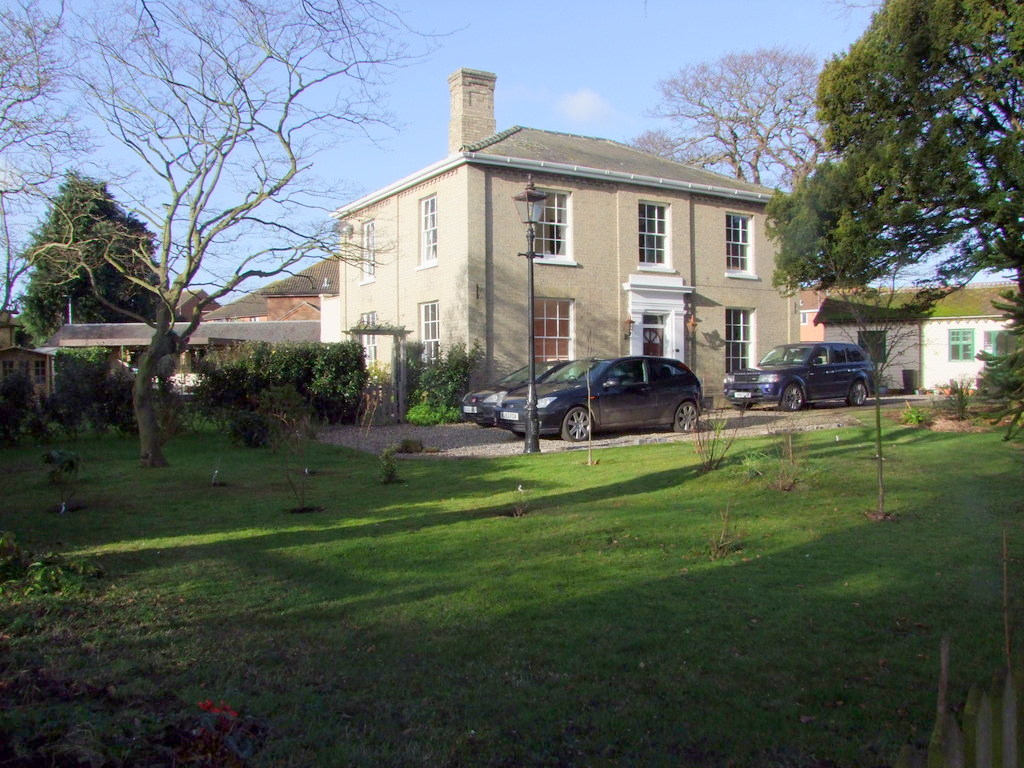
The present owners of the Firs (now called The Oaks) have carefully kept an incredible set of deeds for their house which tell us all about its history. These start with an Abstract of Title dated 1845 which provides details about the land ownership well before the house had even been built. In normal circumstances this may not be of interest but for our house the deeds open a window on its pedigree even before it was built. The house was not named The Firs until about 1881 but I will call it that throughout for identification purposes.
Our story starts in 1812 when the Martham Inclosure Award proves that there were no properties on the field that was simply known then as ‘six acres’ and much of which we now know as the playing field. It was much later that The Firs would be built in its north corner. The deeds open by explaining that William Creasey of Martham had made a will dated 30th January 1788 which described in some detail how he wished to leave his estate. Firstly, he left all his property, lands and belongings to his wife, Mary, and upon her death said his estate should pass to his remaining children and upon their deaths to his grandchildren, if any. William died in 1797 and in accordance with his wishes his wife inherited everything. His wife died only a year later in 1798. At that point their only surviving children were three daughters, Elizabeth, Jane and Diana and they each became the owners of one-third of their father’s estate. So, by the time of the 1812 Inclosure Award, they were the three joint owners of William’s estate a small part of which was ‘six acres’. Landowners were recorded in the 1812 Inclosure Award schedule but perhaps this three-part ownership confused the compilers as ownership of ‘six acres’ was listed in the sole name of Diana Creasey which conflicts with the deeds.
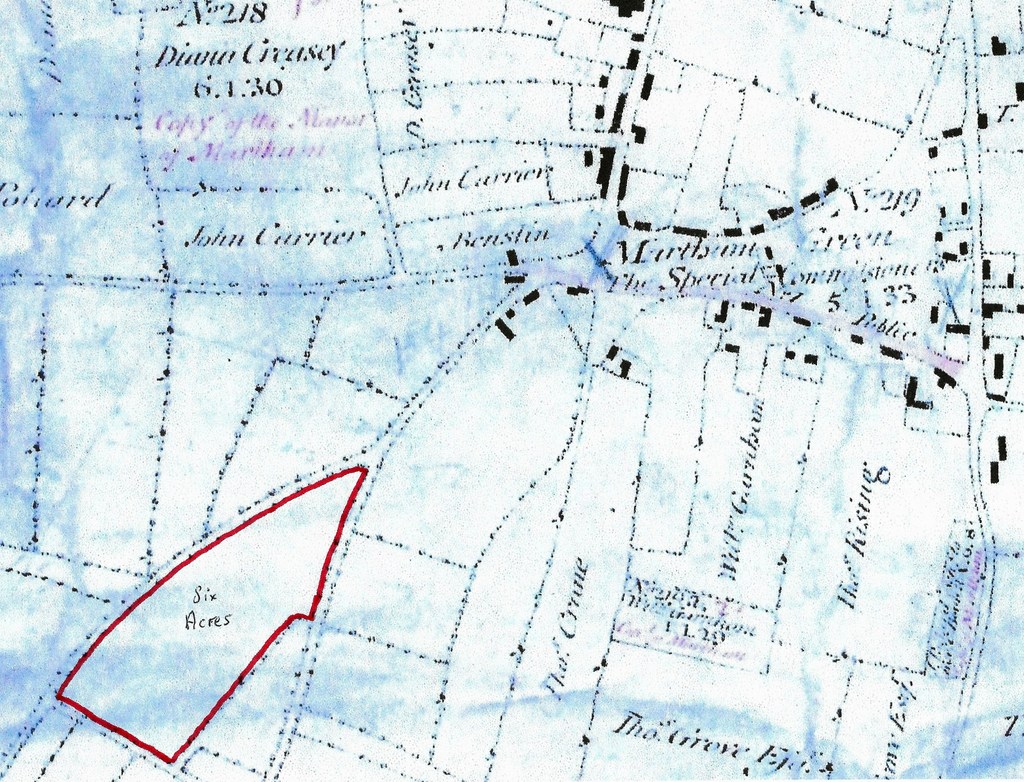
Daughter Elizabeth died in 1825 and Diana in 1834 and neither had any children but their sister Jane did, so the inheritance became even more complicated. I have omitted most of the surnames so far but the following chart may help make this situation a little clearer and will introduce you to spouses and the families they came from which will get us back to the pedigree of the land ownership before the house was built.
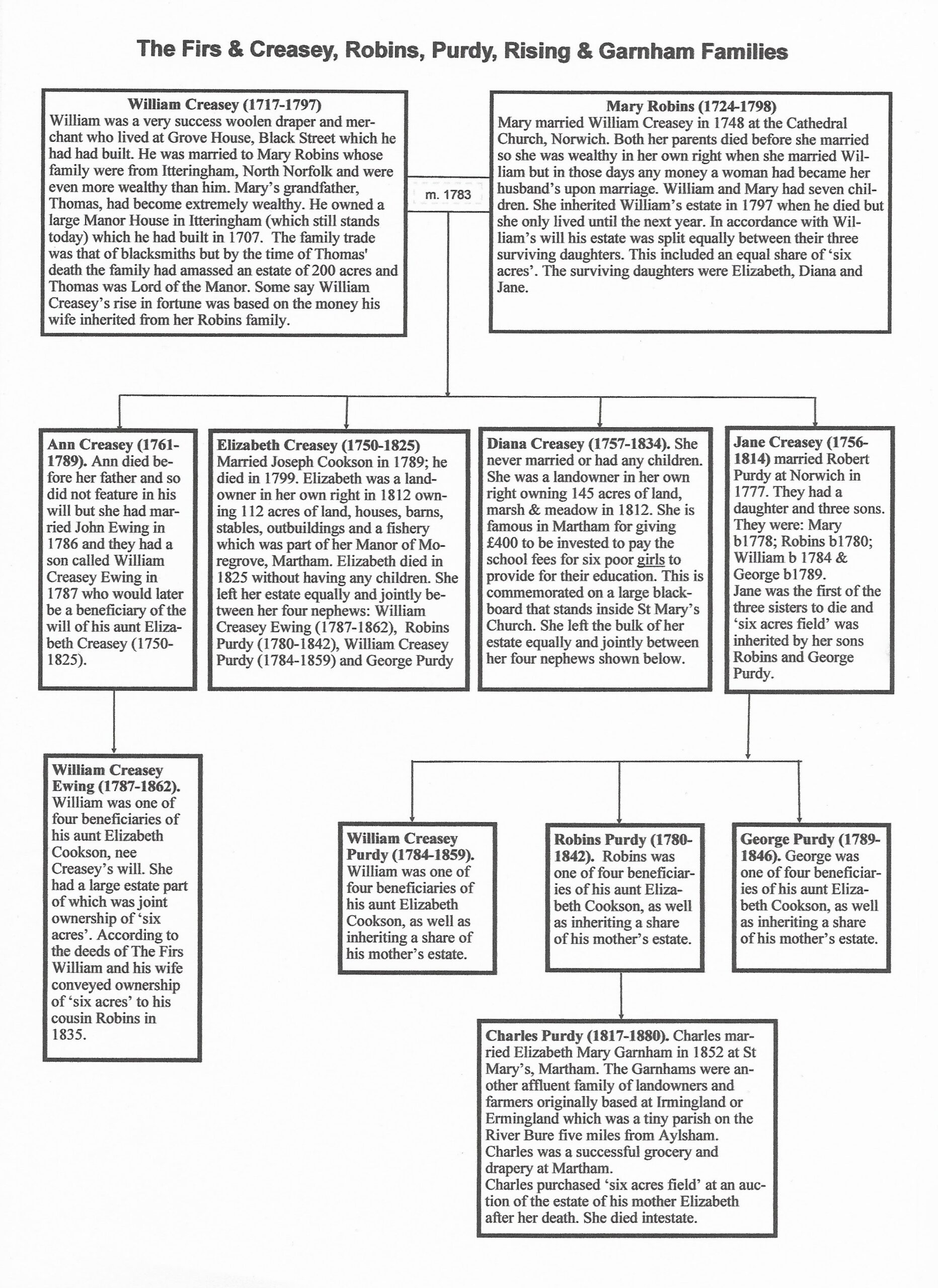
The above family details provide the background to the pedigree of the land The Firs would later be built on and it shows how it was associated with the most eminent and prosperous families in Martham in the mid 19th century being the Purdys, Creaseys, Robins, Risings and Garnhams.
1835 – Having inherited one-third of ‘six-acres’ from his aunt William Creasey Ewing sold it to his cousin Robins Purdy in 1835(1).
1842 – The Firs had not been built at the time of the 1842 Martham Tithe Award but the field it would eventually be built on was plot No158 and it was owned by the widow of Robins Purdy, Anne, nee Rising (1777-1844) who lived at Grove House, Black Street, Martham. The 1842 Tithe Award map is shown on the right.
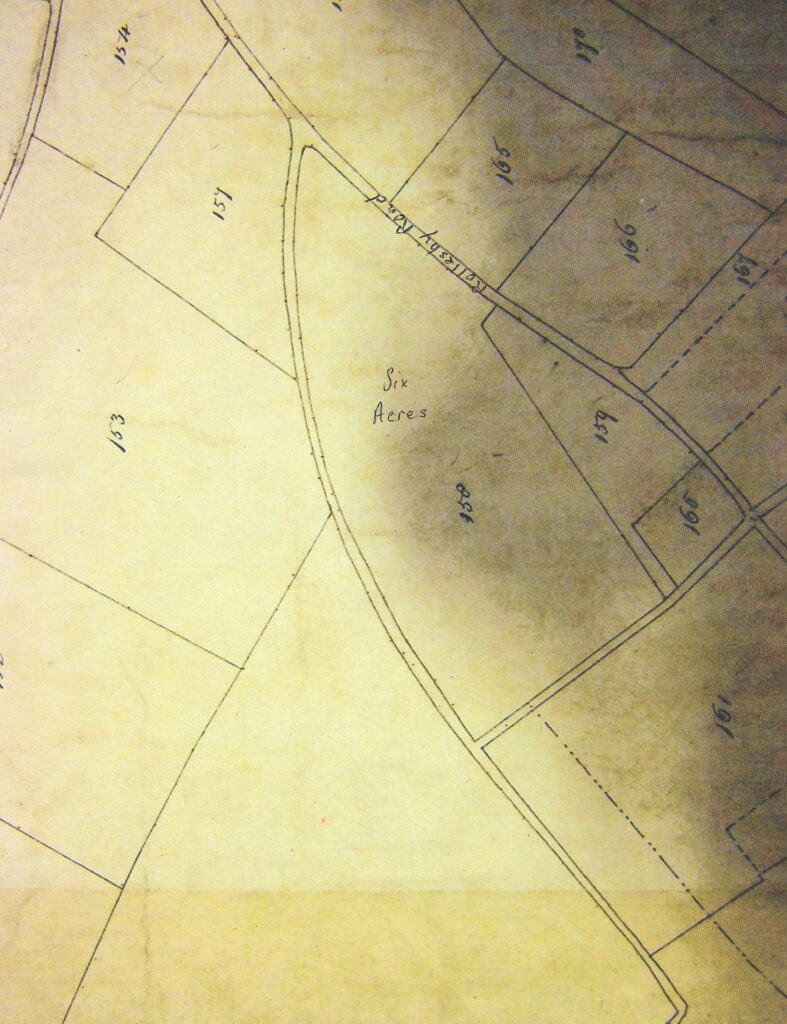

1844 – As a result of the complex inheritance situation arising from various family wills ownership of the ‘six acres field’ had descended to Anne Purdy, nee Rising, and her sons. After her death on 10th April 1844 the executors of her husband Robins abided by his wishes and put his estate up for sale. An auction was held on 28th June 1845 to sell the estate in seven lots and Lot No3 was plot No158 of the Tithe Award or our ‘six-acre arable field’. This lot and another nearby did not sell at the auction but was sold immediately thereafter by a private arrangement to Charles Purdy another of the sons of Robins & Anne Purdy. He paid £610 for lots 3 and 4 and lot 3 was listed in the deeds as ‘Rollesby six acres’. The deeds also tell us that it was Charles Purdy that built The Firs in 1849/50(2). By date the house is Victorian but it was built in the Georgian style as a gentleman’s residence.
1851 – It is not clear from the census who was living at The Firs. It may have been vacant or its construction was not quite finished. Charles was single and lived and traded as a grocer and draper from Norwich House on the Green.
1859-61 – The Firs was not named as such in the 1861 census but Charles and his wife Elizabeth, nee Garnham, who had married at St Mary’s on 10th November 1852 lived at what was listed as Rollesby Lane (Road) at what was certainly our house. Charles was still a grocer and draper. On 2nd February 1859 Charles had made a will leaving all his estate to his wife Elizabeth and naming her as his sole executor.
1871 – Charles & his wife Elizabeth had moved to Cirencester House, The Green, Martham which was over by Back Lane. Its precise location is unknown but it may have been what we now know as Manor Farm. The name Cirencester House does not appear in any other records for Martham.
1878 – The railway station opened in Martham. The Firs is shown on the plans of the railway line. None of the property had anything to do with the railway including the rather fancy outhouse/shed which was in fact built by Bolton and Paul in about 1910 in the style of a railway building or waiting room. It is fully equipped as a holiday let for which it has been used in the past.
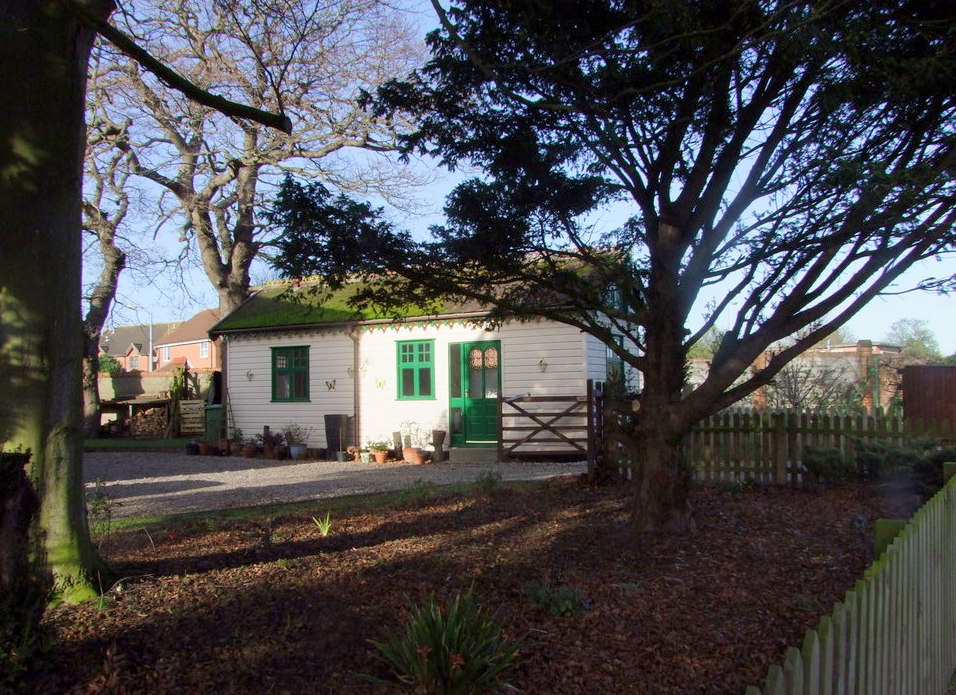
1880-81 Charles died on 13th August 1880 and his widow Elizabeth agreed to sell the house to Martha Ann Love on 6th March 1881 for £805. By this time the house and garden were about two acres in size so the other four acres of the original field must have been sold between 1845 and 1880.
By the time of the 1881 census Elizabeth Purdy had moved and was living with her brother-in-law Robins Purdy (1809-1886) and his wife Mary at 38 High Road, Gorleston, Great Yarmouth. She was 54 and lived off rental income from land.
Although there was an agreement to sell the house in March 1881 Miss Love did not take possession until October that year(4). The house does not appear in the 1881 census carried out on 3rd April 1881 and so it may have been vacant. Martha Ann Love was born in 1843 as the daughter of John & Martha Love of Crostwight Hall, Norfolk. John was an enormously successful gentleman farmer of over 500 acres employing 24 men and three boys in 1881. The deeds imply that he bought the house(3) for his daughter and he actually died there as a widower whilst visiting or living with his daughter on 9th September 1883. Later deeds(3&4) show that it was during the ownership of the house by Martha Ann Love that it was given the name The Firs. Her brother, also named John (1850-1903), farmed at The Hall, Martham and for a short while around 1881 was Lord of the Manor of Martham.
1883-84 We don’t know if it was the death of her father or something else that triggered the end of the short period of ownership by Martha Love but she sold The Firs to Hugh Hannah Millward on 15th November 1883(4) for £1,000. At that time Hugh was a 21-year-old veterinary surgeon who had married Mary Howard Avis Brown in Norwich the previous July 1883. On 1st January 1884 Hugh took out a mortgage of £600 on the property provided by a widow called Ann Cross that he paid by instalments but he remained living at the house. He was in business as a vet which he may have operated from the house but no records exist of his business. He was a keen poultry keeper and won many prizes at local shows for his birds which were no doubt raised at The Firs.
1888 – Hugh and Mary’s marriage broke up; they divorced in February 1888 and by then he had moved to Mareham-le-Fen, Lincolnshire. Mary had already left Martham at that time. Hugh paid off the remaining mortgage debt of £100 he had borrowed from Ann Cross and sold The Firs to Alfred Brooks Halford (1825-1899) & his wife Mary Ann, nee Orford (1827-1916) for £700 in July 1888(5).
1891-1916
Alfred & Mary were still there with two adult daughters at the time of the 1891 census when the house was actually named The Firs in a census for the first time. Alfred was from Hackney, London. Mary was from Lound, Suffolk. Alfred was from a wealthy London family and never seems to have worked but lived off private means and dividends. In the early part of their life, they had married at Great Yarmouth in 1852 and left for Australia the following November aboard the Strathfieldsaye(6). They landed at Sandridge, Victoria(7) the following April 1853. There is no record of what Alfred did in Australia but this was the Australian gold rush period so this may be the reason they went. From about 1852 to 1860 gold was in alluvial deposits and could be found by panning. After about 1860 this source was just about exhausted and many miners left because the only way to get to it was to dig mines which were expensive to set up and the work was both hard and dangerous with profits going mainly to the mine owners. Alfred & Mary had three children in Australia but had returned to England by April 1861 when they were recorded as living with his mother back in Hackney. It was not until many years later in 1888 that they moved to Martham.
Alfred died there on 5th April 1899 but Mary continued to live in the house. Alfred appointed two trustees in his will; one was his son Ernest and the other was his friend Thomas Lewis William Beales. Thomas was a Medical Practitioner/Surgeon and at the time lived at Brooklyn House on The Green. After Mary died at The Firs on 30th March 1916 her son Ernest and Thomas Beales, in acting as trustees, sold the house to Robert Thomas Moore on 17th July 1916(8). So, The Firs was owned by Alfred & Mary Halford from 1888 until 1916.
1916-1946
Robert Moore bought The Firs for £718 10s 6d in 1916 out of the estates of Alfred & Mary Halford(9). Robert was married to Levener, nee Johnson and they were both from Great Yarmouth where he worked in the shipping/fishing industry.
Robert and Levener did not stay long and sold the house to Edith Caroline Hulme Chapman on 24th December 1919 in her sole name even though she was married to George William Chapman. The property was described as being of two acres and 28 perches and changed hands for £800. George was a butcher and farmer and only a few months earlier, in May 1919, had bought Moregrove Hall/Farm. He was the founder of Chapmans Butchers that still exists in the village today. Robert died in 1936 but Edith continued to own the house until 1946 three years before she died in Norwich. The house may have been let during parts of the time that Edith owned it as a T W Sheldon was recorded in the village telephone listed as having phone number ‘Martham 16’ at the house in September 1920. He was a physician and surgeon.
1946-1966
The house was put up for sale by auction on 31st July 1946 by Edith and the sale was handled by Maddison, Miles and Son who produced the catalogue shown below. Interestingly it implies the house was damaged in the Second World War. Also note the mention of a well in the rear yard which still exists today but has been covered with a glass viewing lid. The ‘railway style’ summer house was described as a bungalow and was let at the time to Messrs Crosse & Fairhead, a firm of accountants, that now has their business at Queen Street, Great Yarmouth. The successful bidder was Robert Burns Kirkland who paid £3,250(10).

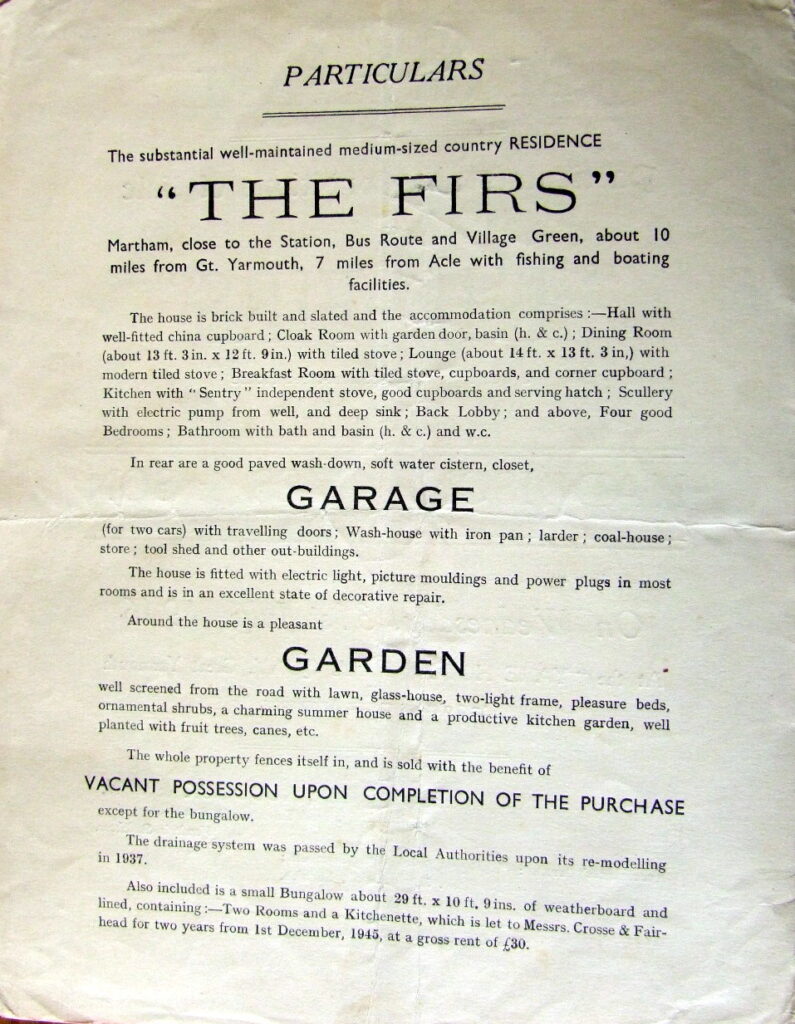
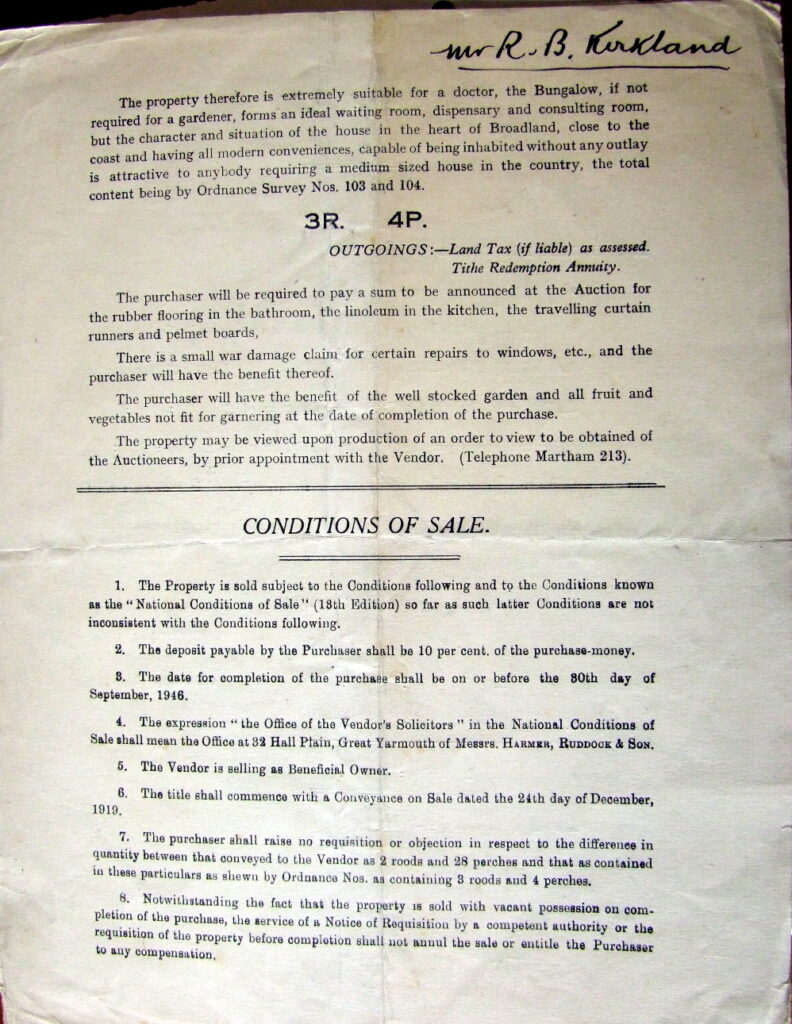
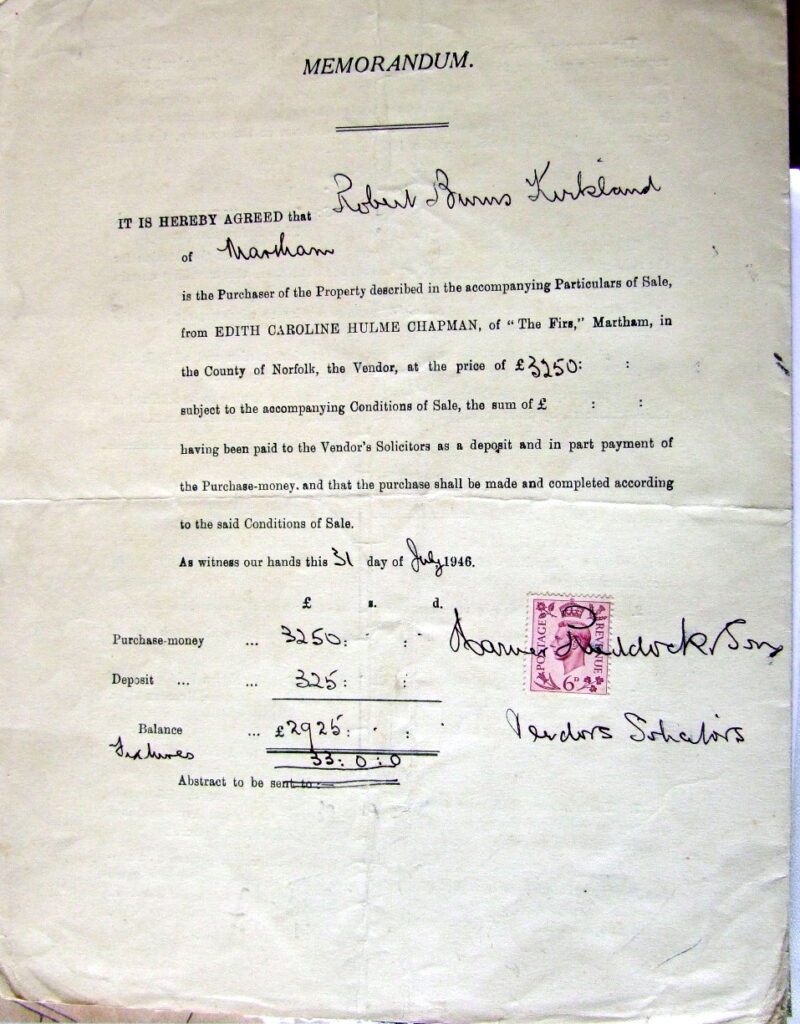
By 1946 Robert Kirkland had established his drapery and outfitters business in his store at White Street and he had been living with his wife and family at the Old School House (Free School) behind the shop. They lived at The Firs for 20 years and eventually sold it to Kenneth Frederick Chadwick in 1966(11).
Kenneth Chadwick purchased the house from the Kirklands on 8th September 1966 for £8,500. He came from Nottinghamshire and was a petroleum engineer. Very little is known about him; he did not stay at the property for long and it is thought that he worked on the then new gas installation at Bacton. He left only about 18 months later and completed two sales on the same day by selling part of the garden on 2nd April 1968 to the south of the site where BT built a switching station. The land, which was sold for £1,650, is shown in green on the map to the right as OS103. This sale left OS104 as the plot, in pink, that he sold on the same day to Bernard Brice for £6,150 as a result(12). The Firs stands on this reduced plot today measuring about three-quarters of an acre. The BT building on OS103 has become redundant and may come up for sale in 2025.
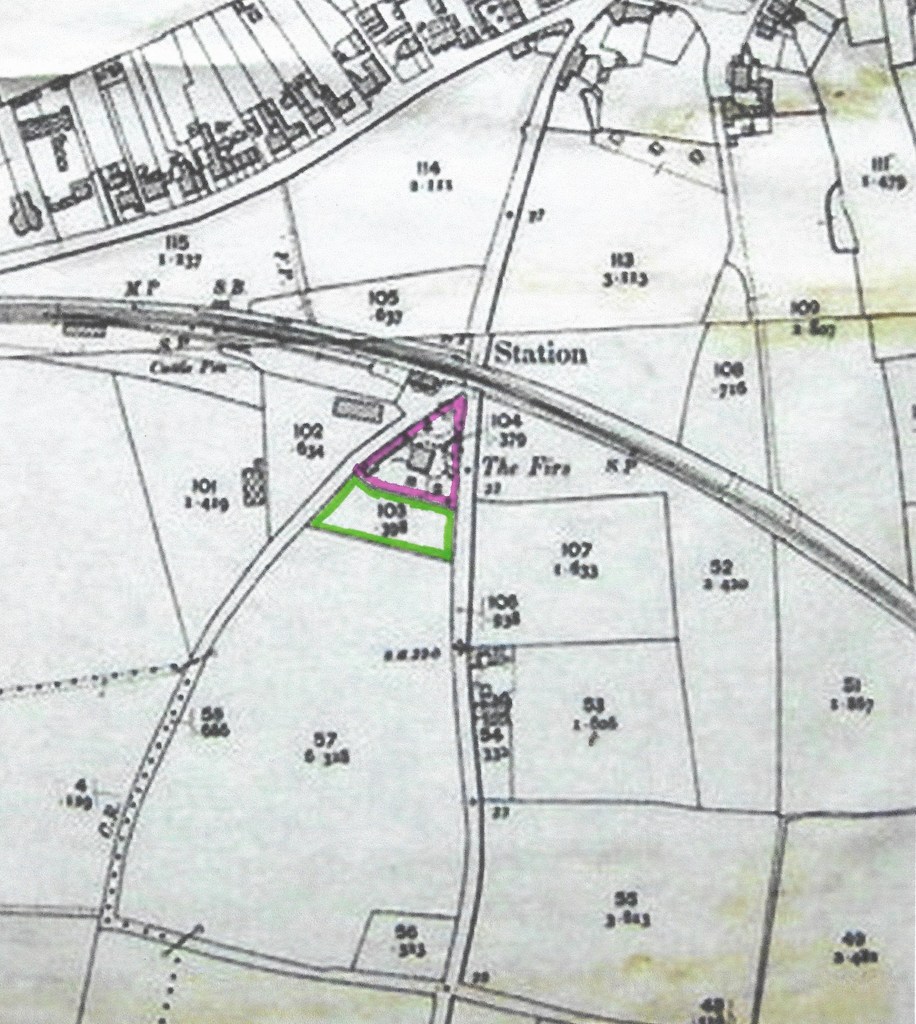
Bernard Brice came from Great Yarmouth and his tenure lasted a little longer, before selling to Mr & Mrs Williams on 20th September 1974 for £8,750(13). In turn the Williams sold the house to the present owners in 2004 who love the history of their home and are busy reinstating some of its Georgian features and have expressed their thanks for my help in researching the history of their house.
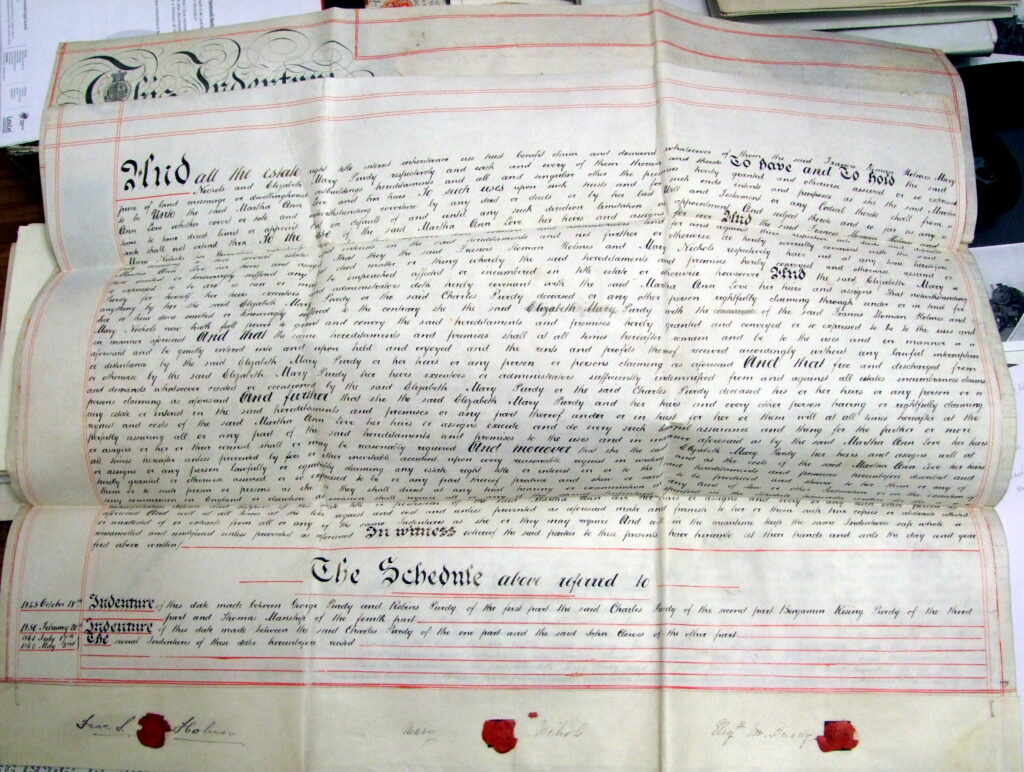
Appendices:
(1) = The Conveyance of Purdy to Love dated 1881 and purchase Agreement date 16th March 1881.
(2) = Page 11 of the Abstract of Title of the deeds of dated 18th October 1845.
(3) = Abstract of Title dated 15th November 1883, Martha Love to Hugh Millward.
(4) = Indenture dated 1st January 1884 between Hugh Hannay Millward and Ann Cross.
(5) = Indenture dated July 1888. Millward to Halford.
(6) = The Strathfieldsaye was built at Chepstow in 1829. It was used as a convict ship between 1835-36 but by 1850 the ship had been in use by paying passengers from England to Australia.
(7) = Sandridge was the name of the locality at the head of Hobsons Bay where colonial passengers disembarked to journey across the sandy land between there and the Yarra River, Melbourne. It is now known as Port Melbourne. The name Sandridge was given by a surveyor, William Darke, in 1839, after the ridge of sand dunes along the beach.
(8) = Halford to Moore Abstract of Title and Conveyance dated 17.7.1916.
(9) = Indenture dated 17.7.1916.
(10) = The Firs Kirkland sale memorandum 1946.
(11) = The Firs Kirkland to Chadwick conveyance 1966.
(12) = The Firs Chadwick to Brice conveyance 1968.
(13) = The Firs Brice to Williams conveyance 1974.